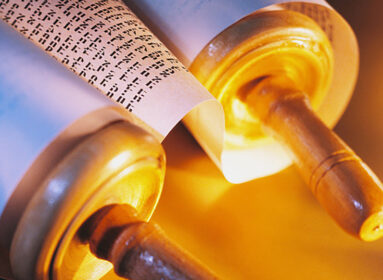The Torah teaches that God created the world by making distinctions, first between light and darkness, next between water and empty space, finally between earth and water. We, too, make distinctions in our lives, and primary among them is the distinction between sacred time and ordinary time. To mark the beginning of sacred time, we light two candles and recite a bracha (blessing). We mark the end of that sacred time period with a ceremony called Havdalah, which means “separation.” It, too, begins with light, as we kindle a braided candle. At the end of Shabbat, we perform the ceremony of Havdalah when three stars appear in the sky. (Havdalah is also performed at the end of other festivals and holy days.)
The primary symbols of Havdalah are the braided candle, kiddush cup containing wine, and spice box containing sweet-smelling spices. The lighted candle symbolizes the light of Shabbat and the strands of the braid have been interpreted as the many types of Jews in the world, all of whom are part of one unified people. The wine is, as always, a symbol of joy. We take one last sip of the joy of Shabbat as we bid the Sabbath goodbye for another week. Similarly, the sweet-smelling spices symbolize the sweetness of Shabbat, whose pleasant aroma we breath in one last time that it might last us through the week to come until we can welcome Shabbat again. There is also a birchat havdalah which praises God for making distinctions, particularly the distinction between the holy and the mundane.
Blessing over the wine
Baruch atah Adonai Elohaynu melech ha-olam, borei p’riy ha-gafen. Blessed are You, Lord, our God, King of the Universe, who creates the fruit of the vine.
Set the cup down without drinking from it and recite the blessing over the spices:
“Baruch atah, Adonai, Elohaynu melech ha’olam., boray minay besamim.” Blessed are You, Lord, our God, King of the universe, creator of the different spices.
Next, recite the blessing over the Havdalah candle:
Baruch atah Adonai Elohaynu melekh ha-olam, borei m’orei ha’eish.
Next everyone raises their hands and looks at their fingernails in the light of the flame and watches the play of shadow and light on their hands. The reason for this practice is that it is important that the participants utilize the light so that the blessing over it is not made in vain. The final blessing is recited:
Baruch atah Adonai Elohaynu melech ha-olam hamavdil bein kodesh l’hol, bein or l’choshech, bein yisrael l’amim, bein yom hashvi’i l’shset ymei ha’ma’ase. Baruch ata Adonai Hamavdil bein Kodesh l’chol.
Blessed are You, Lord our God, ruler of the world, who separates the holy from the mundane, light from darkness, Israel from the other peoples, the seventh day of rest from the six days of work. Blessed are You, Lord, who separates the holy from the mundane.
Take a sip of wine or juice. After drinking the wine, many people have the custom to pour the remaining liquid onto a plate and douse the flame in it.
Source: Jewish Virtual Library, www.jewishvirtuallibrary.org.







 Southern New England Jewish Ledger
Southern New England Jewish Ledger














